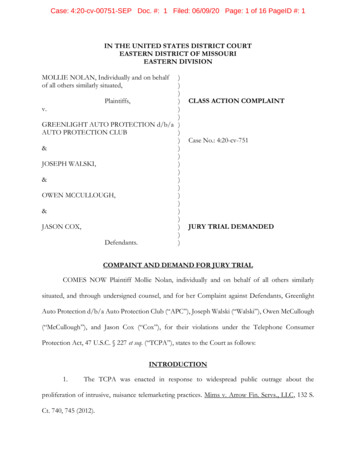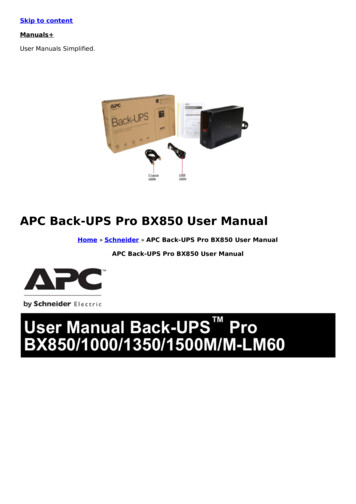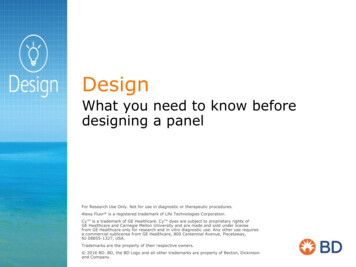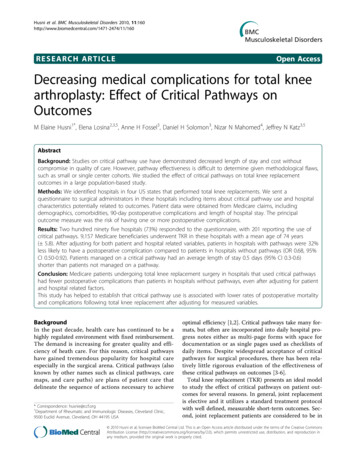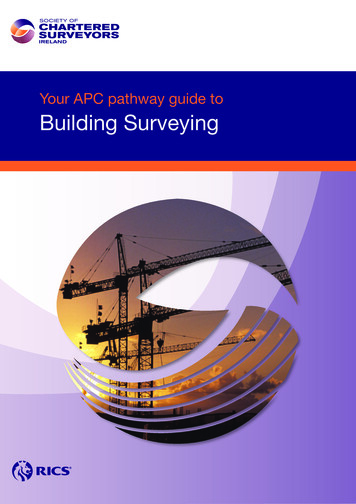
Transcription
Your APC pathway guide toBuilding Surveying
Your pathway guide to Building SurveyingContentsIntroduction4Pathway requirements7Building surveying APC7Competency guidance8Building information modelling (BIM) management (T087)Building pathology (T006)Client care (T003)Commercial management (T010)Conflict avoidance, managementand dispute resolution procedures (M006)Conservation and restoration (T012)Construction technology and environmental services (T013)Contract administration (T016)Contract practice (T017)Design and specification (T021)Design economics and cost planning (T022)Development/project briefs (T024)Fire safety (T033)Health and safety (M008) (must be taken to Level 3)Housing maintenance, repair and improvements (T039)Inclusive environments (T091)Inspection (T044)Insurance (T045)Landlord & tenant (T048)Legal/regulatory compliance (T051)Maintenance management (T053)Measurement (T057)Project finance (T067)Procurement & Tendering (T062)Quantification and costing (T074)Risk management (T077)Sustainability (M009)Works progress and quality management 233343536373
Your pathway guide toBuilding SurveyingIntroductionAbout the APCThe RICS/SCSI Assessment of Professional Competence(APC) ensures that those applying for RICS/SCSImembership are competent to practise and meet the highstandards of professionalism required by RICS/SCSI. There isa widerange of pathways available to qualify as an RICS/SCSImember covering 19 different areas of practice, at APC(Chartered) level.The APC normally consists of: a period of structured training a final assessment.The structured training is based on candidates achieving aset of requirements or competencies. These are a mix oftechnical, professional, interpersonal, business andmanagement skills.4How to use this guideThis guide is designed to help you understand more aboutqualifying as an RICS/SCSI member in building. The materialis set out in three sections.Section one- provides information on this area of practicewith a general overview of the valuation pathway.Section two- lists the competency requirements of thebuilding surveying APC.Section three- describes the main technical competenciesassociated with building, providing expanded sector specificguidance on each of them. This forms the main part ofthe guide.
Your pathway guide toBuilding SurveyingAbout the competenciesChoosing your competenciesThe APC aims to assess that you are competent to carry outthe work of a qualified chartered surveyor. To be competent isto have the skill or ability to perform a task or function. TheRICS/SCSI competencies are not just a list of tasks orfunctions, they are also based upon attitudes and behaviours.The competencies have been drawn up in a generic way sothat they can be applied to different areas of practice andgeographical locations. This guide is designed to help youinterpret these competencies within the context of buildingsurveying.It is important that you give careful thought to your choiceand combination of competencies. Your choice will inevitablyreflect the work you do in your day-to-day environment(driven by the needs of your clients/employer). Your choiceand combination of competencies will be a reflection of yourjudgement. At the final assessment interview, the assessorswill take these choices into account. They will expect you topresent a sensible and realistic choice that reflects the skillsneeded to fulfil the role of a surveyor in your field of practice.The competencies are defined at three levels of attainmentand each APC pathway has its own specific combination ofcompetencies that you must achieve at the appropriate level.You must reach the required level in a logical progression andin successive stages:Level 1 – knowledge and understandingLevel 2 – application of knowledge and understandingLevel 3 – reasoned advice and depth of technical knowledge.The competencies are in three distinct categories:This guide should help candidates and employers with adegree of assistance in choosing the competencies that aremost appropriate to their area of practice.How to find helpSCSI Education and Membership will be able to help you withany general APC queries:T 01 6445500F 01 6611797education@scsi.iewww.scsi.ieMandatory competencies – the personal, interpersonal,professional practice and business competencies common toall pathways and compulsory for all candidates. These areexplained in more detail in the APC Requirements andcompetencies guide.Core competencies – the primary competencies of yourchosen APC pathway.Optional competencies – a set of competencies selected bythe candidate from a list defined for the particular pathway. Inmost cases there is an element of choice. These are mostlytechnical competencies, but certain mandatory competenciesalso appear on the optional competency list and candidatesare permitted to select one of these at a higher level.This guide only deals with the principal core and optionalcompetencies associated with this area. It does not coverthe mandatory competencies.5
Your pathway guide toBuilding SurveyingAbout building surveyingBuilding surveying is one of the widest areas of surveying practice. Chartered building surveyors are involved in allaspects of property and construction from supervising large mixed use developments to planning domesticextensions. This varied workload can include everything from the conservation and restoration ofhistoric buildings to contemporary new developments.Building surveyors work in most real estate markets including residential, commercial, retail, industrial, leisure,education and health. Consequently there are a wide variety of opportunities for chartered building surveyors towork in both the commercial, private, and public sectors. Some chartered building surveyors work for propertyowning clients and contractors as well as in a number of specialist niche areas such as insurance, rights to light,party wall matters etc.As well as strong technical skills, building surveyors need to have strong people skills and the highest levels ofintegrity. Clients, whether a large corporation or a individual member of the public, need to have the utmostconfidence in the impartial advice given by chartered building surveyors.Chartered building surveyors are clearly differentiated from the rest of their market by their enhanced technicalknowledge and professional standards. Achieving the chartered status will enhance your professional status withemployers and clients alike leading to more and and varied employment opportunities.Building surveying APC Preparing strategic property advice covering landownership, lease conditions, boundaries, title mattersBuilding surveyors provide professional technical advice on(including easements, licences and covenants etc),land, property and construction for commercial companiesand landlord and tenant legislationand consultants, central and local government, and private Project management and development monitoringindividuals. Miscellaneous services including accessibility and energyaudits, specialist surveys (asbestos, damp etc),Whichever sector they work in, building surveyors’ knowledgeconservation advice and sustainability advice.and understanding of construction technology and buildingpathology means they are ideally equipped to provide a widerange of services including the following: Managing design and constructionChartered Alternate Designationsrelated to this pathway Undertaking building surveys and measured surveys Analysing design and building defects Preparing strategies for asset management andproperty maintenance Preparing insurance valuations and claims6All candidates qualifying under the building surveyingAPC pathway will be entitled to use the designationchartered building surveyor.
Your pathway guide toBuilding SurveyingPathway RequirementsBuilding surveying APCLevel 3Level 2Level 3Level 3Level1Two to Level 2Plus one toLevel 2 from thefull list of technicalcompetencies, includingany not already chosenfrom the optional list.Mandatory Ethics, rules of conduct & professionalismClient CareCommunication and negotiationHealth and safetyAccounting principles and proceduresBusiness planningConflict avoidance, management and dispute resolution proceduresData managementDiversity, inclusion and teamworkingInclusive environmentsSustainability Building pathologyConstruction technology and environmental servicesContract administrationDesign and specificationInspectionLegal/regulatory complianceFire safety BIM managementCommercial managementClient care (to level 3), or Conflict avoidance, management and dispute resolutionprocedures or Health and safety (to Level 3) or Inclusive environments or SustainabilityConservation and restorationContract practiceDesign economics and cost planningDevelopment/project briefsFire safetyHousing maintenance, repair and improvements or Maintenance managementInsuranceLandlord and tenantMeasurementProcurement and tenderingProject financeQuantification and costingRisk managementWorks progress and quality management CoreOptional7
Your pathway guide toBuilding SurveyingCompetency GuidanceThe pages that follow are intended to provide guidance for users on the maincompetencies associated with building surveying.The guidance has been drawn up by experienced practitioners and aims to give you aclear and practical understanding of how to apply the listed core and optionalcompetencies in the context of building surveying. The guidance does not cover themandatory competency requirements.The official competency definitions (at levels one, two and three) are provided, followedby a description of the key knowledge and activities that are likely to fall within thescope of each competency.The information provided is designed to be helpful but informal guidance. Theknowledge and activities described under each competency are not exhaustive, andshould not be relied upon as any form of revision list. Candidates must satisfythemselves and their employers that they have reached the required level of attainmentbefore applying for final assessment.The competencies are arranged in alphabetical order.Building information modelling (BIM) management (T087)Building pathology (T006)Client care (T003)Commercial management (T010)Conflict avoidance, managementand dispute resolution procedures (M006)Conservation and restoration (T012)Construction technology and environmental services (T013)Contract administration (T016)Contract practice (T017)Design and specification (T021)Design economics and cost planning (T022)Development/project briefs (T024)Fire safety (T033)Health and safety (M008) (must be taken to Level 3)Housing maintenance, repair and improvements (T039)Inclusive environments (T091)Inspection (T044)Insurance (T045)Landlord & tenant (T048)Legal/regulatory compliance (T051)Maintenance management (T053)Measurement (T057)Project finance (T067)Procurement & Tendering (T062)Quantification and costing (T074)Risk management (T077)Sustainability (M009)Works progress and quality management 323334353637
Your pathway guide toBuilding SurveyingBuilding information modelling(BIM) managementReference no. T087Description of competency in context of this sectorThis competency encompasses the establishment and management of the information modelling systems on projects. Itcovers collaborative process and technological principles involved in implementing Building Information Modelling (BIM).Examples of likely knowledge, skills and experience at each levelLevel 1Level 2Level 3Demonstrate knowledge andunderstanding of the technical,process and collaborative aspectsof the use of BIM on projects.Develop and apply managementsystems to facilitate the use of BIMon projects including unified controland reporting procedures.Show how the knowledge andexperience gained in this competencyhas been applied to advising clientsand/or senior management on BIMstrategy.Examples of knowledge comprisedwithin this level are: Understanding of BIM strategiesand implementation Understanding of the varioustechnical options and solutions forinformation modelling Understanding of the collaborativeprocesses necessary for BIMadoption Knowledge of standardclassification systems and their usein infrastructure Knowledge of relevantinternationally recognisedmanagement standards such asConstruction Operations BuildingInformation Exchange (COBie)Examples of activities and knowledgecomprised within this level are: Preparation of a BIM execution plan Design and implementation of a BIMmanagement process Analysis of comparative BIMsolutions Maintenance of an information model Agree and implement contractualaspects of BIM such as separateprotocol Facilitate and manage project teammembers for BIM implementationExamples of activities and knowledgecomprised within this level are: Analysing, assessing, evaluating andreporting on options for BIMstrategies at a corporate or projectlevel Designing and advising oncollaborative strategies for thesuccessful implementation of BIM onprojects Advising on the contractual andcommercial implications of using BIMon projects Advising on options for software andprotocols on BIM projects Advising on technical informationsystems requirements for BIM atcorporate or project level9
Your pathway guide toBuilding SurveyingBuilding pathologyReference no. T006Description of competency in context of this sectorBuilding pathology is core to many areas of surveying. It is essential that all candidates have an understanding of defectsanalysis, and the likely resultant defects from failures in building fabric. This will range from the effects of a defective waterproofcovering at simple building pathology, to much more complex defects such as interstitial condensation, and the possible effectson building fabric. Candidates will be expected to have an in-depth knowledge of the range of defects found in typical buildingsin their locality, as well as an understanding of defects that they may come across more infrequently. In order to be competentin building pathology and defects analysis candidates will need to have detailed construction technology knowledge.Examples of likely knowledge, skills and experience at each levelLevel 1Level 2Level 3Examples of knowledge comprisedwithin this level are: On typical building defects explaincause and effect of these forexample, dampness, timber defect,building movements Building defects likely to beencountered in typical buildingsurveying activities Differing types of testing, and thelimitations of the tests, for examplethe use of damp meters, andborescopes Construction detailing of differentbuilding types and through ages ofconstruction.Examples of activities and knowledgecomprised within this level are: Identify in detail cause andmechanics of varying types of failure Using detailed examples, explain therelationship between observationstaken on site and the diagnosis offailure in building fabric Information gathered from severalsources, including if necessaryspecialist inspections, to diagnoseand explain building fabric failure Demonstrate an understanding of theappropriate level of detail required intypical reports, including examples oflayout, and the use of sketches/drawings and photographsExamples of activities and knowledgecomprised within this level are: Explaining the causes of failure, andthe likely results of failure, togetherwith recommendations of appropriateremedial measures Analysing information gathered frominspections to formulate thenecessary remedial/preventativeworks including specific detail, in theform of a schedule of works, ifrequired with sketches/ drawings andphotographs Discussing in detail examples ofunusual defects you have identifiedand the remedial worksrecommended.Demonstrate your knowledge andunderstanding of building defects,including collection of information,measurements, and tests.10Apply your knowledge to undertakesurveys, use survey and otherinformation to diagnose cause andmechanisms of failure.Give reasoned advice andappropriate recommendations,including the preparation andpresentation of reports.
Your pathway guide toBuilding SurveyingClient careReference no. T003Description of competency in context of this sectorThis competency covers how a surveyor meets a client’s brief in respect of a specific appointment and how they deal with aclient from a business and professional perspective. The term ‘client’ as it is used in this competency means not only thecontractual party who has appointed the surveyor, but also all of the stakeholders in a project with whom the surveyor has toengage. This competency is closely linked to Ethics, Rules of Conduct and professionalism, which defines professionalbehaviour and sets out some mechanisms for protecting clients.Examples of likely knowledge, skills and experience at each levelLevel 1Level 2Level 3Examples of knowledge comprisedwithin this level are: The information contained within aclient’s brief Defining your scope of services within thelimits of your competence and PIinsurance How fees are established The use of standard forms ofappointment Mechanisms contained within anappointment document Insurance requirements (legal andRICS/SCSI) How stakeholders are identified and howtheir status within the project isestablished Formal communicationsystems with clients and stakeholders Complaints handling procedures Key Performance Indicators (KPIs) The methods of data gathering during theinception stage of a project includingclient briefings and site based information The law applicable to your area ofpractice, in particular those relating toemployment law, statutory compliance,consents and approvals The principles of the preparation ofalternative outline proposals including themethodology of preparing an optionappraisals The principles of preparing outlineschedules of work.Examples of activities and knowledgecomprised within this level are: Compiling an appointment document Establishing project stakeholders andtheir status Setting up communication systems witha client and stakeholders Issuing reports to a client e.g. costreports Dealing with a complaint Measurement of KPIs Analysing the data gathered throughthe client briefing process andformulating a detailed client brief Consulting with the statutory authoritieson the consents and other approvalsrequired Preparing alternative outline designproposals, including option appraisals Preparing outline schedules of work Assessing client relationships, teamperformance and stakeholder interfaceson international projects.Examples of activities and knowledgecomprised within this level are: Developing tailored proposals linked tobusiness strategies Presenting a prioritised and informedbrief to enable decision making Value management with stakeholders toensure delivery against clientexpectations Advising on the need for statutory andother consents and approvals Presenting alternative proposalsincluding option appraisals Presenting outline schedules of work Agreeing the level of fees with a client Issuing an appointment document Ensuring insurances are in place Setting performance levels and KPIs Monitoring compliance with the scopeof services Monitoring performance internally andexternally against client/ stakeholderperformance levels Reporting to clients and stakeholders Using KPIs to improve performance.Demonstrate knowledge andunderstanding of the principles andpractice of client care including: The concept of identifying all clients/colleagues/third parties who are yourclients and the behaviour that isappropriate to establish good clientrelationships The systems and procedures that areappropriate for managing the processof client care, including complaints The requirement to collect data,analyse and define the needs of clients.Provide evidence of practicalapplication of the principles andpractice of client care in your areaof practice.Provide evidence of reasoned advicegiven to clients and others11
Your pathway guide toBuilding SurveyingCommercial managementReference no. T010Description of competency in context of this sectorThis competency covers the commercial management of construction works. Candidates should have an awareness of howcommercial competitiveness balances against profitability. They must have a thorough understanding of the financial processesused to achieve profitability and how these integrate with the overall delivery of the project.Examples of likely knowledge, skills and experience at each levelLevel 1Level 2Level 3Examples of knowledge comprisedwithin this level are: Identifying and understanding thecomponents that make up the costof the project to the contractor Understanding of the effect that thedesign and construction processeshave on the cost Awareness of the techniques usedto reconcile the cost against income Awareness of the techniques tofinancially manage sub-contractorsand suppliers Understanding the use ofcashflows.Examples of activities and knowledgecomprised within this level are: Collecting of data for reports Carrying out cost to completionexercises Preparing cashflows Preparing reports such as liabilitystatements, cost to complete andcost value reconciliations Applying value engineering processes Preparing and submitting cost datafor in-house and/or external use inrelation to areas such as cost ofpreliminaries, comparative cost ofdifferent construction techniques andtaxation allowances.Examples of activities and knowledgecomprised within this level are: Monitoring, analysing, reporting andadvising at a senior level on projectcashflows and profitability forinternal use Evaluating and advising on financialimplications and appropriatemanagement actions.Demonstrate knowledge andunderstanding of the principles ofthe management of constructionprojects.12Apply your knowledge to thefinancial management ofconstruction projects, includingregular monitoring and reportingon cashflow and profitability.Monitor, report and advise onproject cashflows and profitability.Evaluate and advise on the financialimplications and appropriatemanagement actions.
Your pathway guide toBuilding SurveyingConflict avoidance, managementand dispute resolution proceduresReference no. M006Description of competency in context of this sectorThis competency covers the surveyor’s involvement with the avoidance, management and resolution of disputes inconstruction projects. Candidates should be aware of the various processes and techniques commonly used in the industry.They should have a detailed understanding of how these are applied in practice.Examples of likely knowledge, skills and experience at each levelLevel 1Level 2Level 3Examples of knowledge comprisedwithin this level are:A basic knowledge and understandingof some of the following, as mostappropriate to your marketsector/areas of specialism: Common causes of disputes The contribution of some of thefollowing to dispute avoidance:– Risk management (its basicprinciples and techniques)– Early warning systems– Partnering techniques– Clear and robust client briefings Theories of negotiation and the roleof effective communication andnegotiation The primary features, advantagesand disadvantages of a range ofdispute resolution procedures andtheir surrounding statutory and/ornon-statutory legal/ judicial context(e.g. how forms of contract dealwith dispute resolution, and thescope of such clauses):Examples of activities and knowledgecomprised within this level are: Adopting – or encouraging theadoption of (as appropriate) –suitable dispute avoidancetechniques Negotiating actively on behalf ofclients (e.g. performance failure,unavailability, contract variations,contract interpretations andpayment) prior to third-party referral Assisting in the collation orpreparation of claims/counterclaimsand submissions Assisting in the identification,gathering and collation of facts andexpert evidence for use in expertreports Sufficient understanding of the mainpoints of the statutory or nonstatutory law relevantto/underpinning any particulardispute resolution process and itsapplicationExamples of activities and knowledgecomprised within this level are: Advising clients of the most suitablemeans of dispute avoidance on theirprojects, and of dispute resolutionprocedures appropriate to theirindividual circumstances,demonstrating appreciation of whento seek further specialist advice andwhen to advise clients within thescope of the insurance cover of thecandidate’s organisation. Involvement in, or assistance with, areferral to a third-party resolutionprocess and associatedmanagement of that process onbehalf of client.Demonstrate knowledge andunderstanding of the techniques forconflict avoidance, conflictmanagement and dispute resolutionprocedures including for exampleadjudication and arbitration,appropriate to your APC pathway.continued next page Provide evidence of practicalapplication in your area of practicehaving regard to the relevant law.Provide evidence of the applicationof the above in the context ofadvising clients in the variouscircumstances referred to above.NB: Please note that the roles of actingas a third-party dispute resolver – orexpert witness, are – for the vastmajority of candidates – not likely to bean activity that is undertaken. It is only asmall minority of candidates withsubstantive work experience for whomthis is likely to be relevant.13
Your pathway guide toBuilding SurveyingConflict avoidance, managementand dispute resolution proceduresReference no. M006(continued)Examples of likely knowledge, skills and experience at each levelLevel 1(Continued)Examples of knowledge comprisedwithin this level are: (continued)– Mediation (could includecontracted and project mediation)and conciliation– Dispute Resolution Boards (DRBs)– Dispute Resolution Advisers (DRAs)– Adjudication– Independent expert determination– Arbitration– Litigation The possible roles of a surveyor asan expert witness and/or anadvocate, to include an awarenessof the existence and scope ofapplicability of RICS guidance forexpert witnesses andadvocates The range of nominating bodies andservices available to resolvedisputes, and particularly the role ofthe RICS/SCSI Dispute ResolutionService and any specialised disputeresolution schemes it offers relevantto your market sector The RICS Global ProfessionalStatement on Conflict of Interestand any appropriate SCSI guidance.14Level 2Level 3
Your pathway guide toBuilding SurveyingConservation and restorationReference no. T012Description of competency in context of this sectorThis competency is about understanding historic buildings/structures and the factors that influence performance and futureongoing use. This requires a sound understanding of principles, philosophy, materials, architectural history and the law toenable practical sustainable solutions to be devised to ensure ongoing benefit for the built heritage. Conservation andrestoration can be compatible, but can more frequently bring about conflict and this competency seeks to ensure thecandidate is equipped to understand the issues and negotiate solutions.Examples of likely knowledge, skills and experience at each levelLevel 1Level 2Level 3Examples of knowledge comprisedwithin this level are: The law applicable to conservation The definitions used in conservation(such as listed building, scheduledancient monument, conservationarea) The principles of conservation Identification of age, styles andmaterials Understanding the diversity ofmaterials and techniques used inthe construction of historicstructures Differentiating between conservationand restoration (as well aspreservation and refurbishment) The lime cycle Breathable building technology Understanding factors that lead toredundancy of a building.Examples of activities and knowledgecomprised within this level are: Undertaking condition surveys Undertaking architecturalassessments Preparing statements of significance Preparing reports identifyingmaterials, periods of construction(including historic alterations), typicaldefects/problems Preparing and submitting applications– eg listed building consent Preparing schedules of work forstandard repairs using traditionalmaterials Assessing the impact of moderntechnology and repair methods ontraditional buildings, structures,elements and materials Assessing and reporting on factorsthat are resulting or could result inredundancy.Examples of activities and knowledgecomprised within this level are: Preparing a conservationmanagement plan Preparing a sustainable/justifiablephilosophical approach to guide bothpresent and future works (repairs andalterations) Preparing schedules of work in detailfor a variety of situations (nonstandard) Undertaking programme of worksover a period of years Providing advice on appropriate repairmethods Providing advice on appropriateworks to ensure continued use of abuilding, or to bring back into use aredundant building Discussing and advising uponalternative repair methods Considering assessing and advisingupon non standard approaches torepair and re-use Advising on situations whereincompatibility of materials is found tobe detrimental to the future of thestructure or element Negotiating where conservation isperceived to be a barrier to the futureuse of a building and/or restoration.Demonstrate knowledge andunderstanding of the principles,techniques and methods applied toconservation and restoration.Undertake an inspection or objectidentification to identify all therelevant factors that may affect theconservation or restoration of thesubject matter.Provide evidence of reasoned adviceon the conservation or restoration ofthe subject matter and/or managethe conservation or restorationprocess.15
Your pathway guide toBuilding S
A ll candidates qualifying under the building surveying APC pathway will be entitled to use the designation chartered building surveyor. 6 Building surveying APC Building surveyors (provide professional technical advice on land, property and construction for commercial companies and consultants, central and local government, and private .





